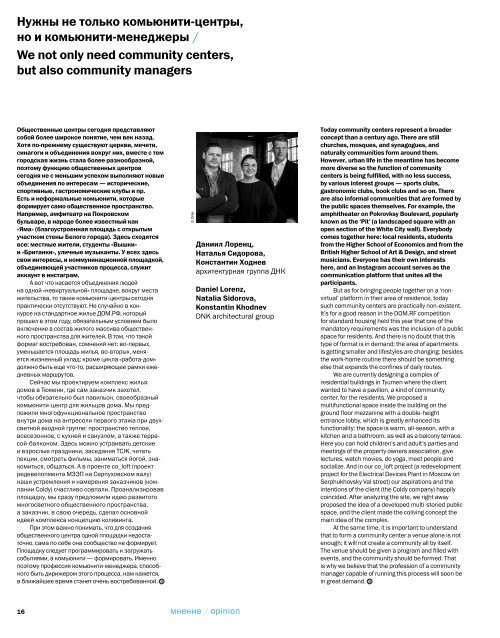speech: 21 community centre
ISBN 978-3-86859-848-3 https://www.jovis.de/de/buecher/product/speech-21.html
ISBN 978-3-86859-848-3
https://www.jovis.de/de/buecher/product/speech-21.html
You also want an ePaper? Increase the reach of your titles
YUMPU automatically turns print PDFs into web optimized ePapers that Google loves.
Нужны не только комьюнити-центры,<br />
но и комьюнити-менеджеры /<br />
We not only need <strong>community</strong> centers,<br />
but also <strong>community</strong> managers<br />
Общественные центры сегодня представляют<br />
собой более широкое понятие, чем век назад.<br />
Хотя по-прежнему существуют церкви, мечети,<br />
синагоги и объединения вокруг них, вместе с тем<br />
городская жизнь стала более разнообразной,<br />
поэтому функцию общественных центров<br />
сегодня не с меньшим успехом выполняют новые<br />
объединения по интересам — исторические,<br />
спортивные, гастрономические клубы и пр.<br />
Есть и неформальные комьюнити, которые<br />
формирует само общественное пространство.<br />
Например, амфитеатр на Покровском<br />
бульваре, в народе более известный как<br />
«Яма» (благоустроенная площадь с открытым<br />
участком стены Белого города). Здесь сходятся<br />
все: местные жители, студенты «Вышки»<br />
и «Британки», уличные музыканты. У всех здесь<br />
свои интересы, и коммуникационной площадкой,<br />
объединяющей участников процесса, служит<br />
аккаунт в инстаграм.<br />
А вот что касается объединения людей<br />
на одной «невиртуальной» площадке, вокруг места<br />
жительства, то такие комьюнити-центры сегодня<br />
практически отсутствуют. Не случайно в конкурсе<br />
на стандартное жилье ДОМ.РФ, который<br />
прошел в этом году, обязательным условием было<br />
включение в состав жилого массива общественного<br />
пространства для жителей. В том, что такой<br />
формат востребован, сомнений нет: во-первых,<br />
уменьшается площадь жилья, во-вторых, меняется<br />
жизненный уклад: кроме цикла «работа-дом»<br />
должно быть еще что-то, расширяющее рамки ежедневных<br />
маршрутов.<br />
Сейчас мы проектируем комплекс жилых<br />
домов в Тюмени, где сам заказчик захотел,<br />
чтобы обязательно был павильон, своеобразный<br />
комьюнити-центр для жильцов дома. Мы предложили<br />
многофункциональное пространство<br />
внутри дома на антресоли первого этажа при двухсветной<br />
входной группе: пространство теплое,<br />
всесезонное, с кухней и санузлом, а также террасой-балконом.<br />
Здесь можно устраивать детские<br />
и взрослые праздники, заседания ТСЖ, читать<br />
лекции, смотреть фильмы, заниматься йогой, знакомиться,<br />
общаться. А в проекте co_loft (проект<br />
редевелопмента МЗЭП на Серпуховском валу)<br />
наши устремления и намерения заказчиков (компании<br />
Coldy) счастливо совпали. Проанализировав<br />
площадку, мы сразу предложили идею развитого<br />
многосветного общественного пространства,<br />
а заказчик, в свою очередь, сделал основной<br />
идеей комплекса концепцию коливинга.<br />
При этом важно понимать, что для создания<br />
общественного центра одной площадки недостаточно,<br />
сама по себе она сообщество не формирует.<br />
Площадку следует программировать и загружать<br />
событиями, а комьюнити — формировать. Именно<br />
поэтому профессия комьюнити-менеджера, способного<br />
быть дирижером этого процесса, нам кажется,<br />
в ближайшее время станет очень востребованной.<br />
© DNK<br />
Даниил Лоренц,<br />
Наталья Сидорова,<br />
Константин Ходнев<br />
архитектурная группа ДНК<br />
Daniel Lorenz,<br />
Natalia Sidorova,<br />
Konstantin Khodnev<br />
DNK architectural group<br />
Today <strong>community</strong> centers represent a broader<br />
concept than a century ago. There are still<br />
churches, mosques, and synagogues, and<br />
naturally communities form around them.<br />
However, urban life in the meantime has become<br />
more diverse so the function of <strong>community</strong><br />
centers is being fulfilled, with no less success,<br />
by various interest groups — sports clubs,<br />
gastronomic clubs, book clubs and so on. There<br />
are also informal communities that are formed by<br />
the public spaces themselves. For example, the<br />
amphitheater on Pokrovksy Boulevard, popularly<br />
known as the ‘Pit’ (a landscaped square with an<br />
open section of the White City wall). Everybody<br />
comes together here: local residents, students<br />
from the Higher School of Economics and from the<br />
British Higher School of Art & Design, and street<br />
musicians. Everyone has their own interests<br />
here, and an Instagram account serves as the<br />
communication platform that unites all the<br />
participants.<br />
But as for bringing people together on a ‘nonvirtual’<br />
platform in their area of residence, today<br />
such <strong>community</strong> centers are practically non-existent.<br />
It’s for a good reason in the DOM.RF competition<br />
for standard housing held this year that one of the<br />
mandatory requirements was the inclusion of a public<br />
space for residents. And there is no doubt that this<br />
type of format is in demand: the area of apartments<br />
is getting smaller and lifestyles are changing: besides<br />
the work-home routine there should be something<br />
else that expands the confines of daily routes.<br />
We are currently designing a complex of<br />
residential buildings in Tyumen where the client<br />
wanted to have a pavilion, a kind of <strong>community</strong><br />
center, for the residents. We proposed a<br />
multifunctional space inside the building on the<br />
ground floor mezzanine with a double-height<br />
entrance lobby, which is greatly enhanced its<br />
functionality: the space is warm, all-season, with a<br />
kitchen and a bathroom, as well as a balcony terrace.<br />
Here you can hold children’s and adult’s parties and<br />
meetings of the property owners association, give<br />
lectures, watch movies, do yoga, meet people and<br />
socialize. And in our co_loft project (a redevelopment<br />
project for the Electrical Devices Plant in Moscow on<br />
Serphukhovsky Val street) our aspirations and the<br />
intentions of the client (the Coldy company) happily<br />
coincided. After analyzing the site, we right away<br />
proposed the idea of a developed multi-storied public<br />
space, and the client made the coliving concept the<br />
main idea of the complex.<br />
At the same time, it is important to understand<br />
that to form a <strong>community</strong> center a venue alone is not<br />
enough; it will not create a <strong>community</strong> all by itself.<br />
The venue should be given a program and filled with<br />
events, and the <strong>community</strong> should be formed. That<br />
is why we believe that the profession of a <strong>community</strong><br />
manager capable of running this process will soon be<br />
in great demand.<br />
16 мнение / opinion


















